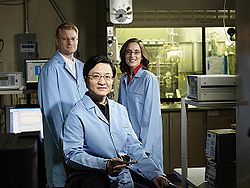Catalyst
A Catalyst is a substance that is added to a mixture to help speed up the reaction of that mixture. Catalysts are in many substances people use everyday. Even the caffeine in the coffee you drink is a catalyst. Catalysts are all around us, and are essential in getting things done faster. This is commonly seen when it comes to factories that want to mass-produce a great quantity of a specific product. Without catalysts, production would take twice as long, making the company less successful. [1]
Properties
Catalysts come in many different forms. They can be synthetic, organic, or made of metal. When a catalyst is added to a substance, it does not change the catalyst or the substance itself. At the end of the reaction, there will be the product and the catalyst remaining. This allows the catalyst to be reused in similar reactions. They can be in a liquid or a solid form, such as : Caffeine or sulfuric acid.
Uses
A catalyst is any substance that speeds up the reaction rate of a chemical reaction without itself being changed during the reaction. A process caused by a catalyst is called catalysis. The catalyst helps lower the activation energy needed to start a reaction between two substances. This greatly decreases the time needed for the reaction to finish. After the reaction has been completed, the catalyst will remain the same. Most catalysts are reusable. Some substances can't even react at all without the help of a catalyst.[2] One example of a reaction that needs a catalyst to work is between hydrogen and oxygen gases, producing water. There are many different types of catalysts. Some common examples of these include enzymes in our body, fertilizers in plants, caffeine in drinks.
Catalysts play an important role in the life of every living organism. The most common catalysts are enzymes. Enzymes are used mainly in the process of digestion. They are in saliva, and help digest food quickly. Without their help, it could take weeks or even months to digest a bit of food. Another common form of catalysts that most people are familiar with are fertilizers. Fertilizers help speed up and promote plant growth. Catalysts are also used in making soap. Catalysts also work the exact opposite way. Some medical uses for catalysts include using them as inhibitors. Inhibitors are catalysts that slow down a reaction. This is very helpful when it comes to a disease or illness that a patient has contracted. The doctor can apply an inhibitor to help slow down the disease, giving them further time to help the patient. Many industries use catalysts to help create their products faster, thus increasing productivity. Without these essential catalysts, they would not be making half as many products as they are today!
History
Many people have used catalysts all throughout the history of science, although they did not realize that what they had was really a catalyst. In the year 1812, Gottlieb Sigismund Constantin Kirchhof, a Russian chemist, tried an experiment that involved putting starch into boiling water. After almost every try, he found that the starch had made no change at all. But when he added a couple drops of concentrated sulfuric acid, the starch started breaking down and formed glucose (sugar). After all the starch had broken down, Kirchhof discovered that the sulfuric acid still remained unchanged at the bottom. It was in this moment that he realized that the sulfuric acid was just assisting the reaction, allowing it to react faster.[3] The name for catalysis came from the Greek words kata (down) and lyein (loosen), loosen down meaning to wear down or break the bonds between the compounds. This name was given by Jons Jakob Berzelius, a Swedish chemist, in the year 1835. Since then, many people have been discovering new catalysts for all kinds of different reactions.
References
- ↑ Catalysis Types Jim Clark, July 2007
- ↑ What is a Catalyst? J. Gunsch, wiseGEEK, March 12, 2011.
- ↑ Kirchhof and Catalysts Advameg Inc, 2011.
| ||||||||||||||


